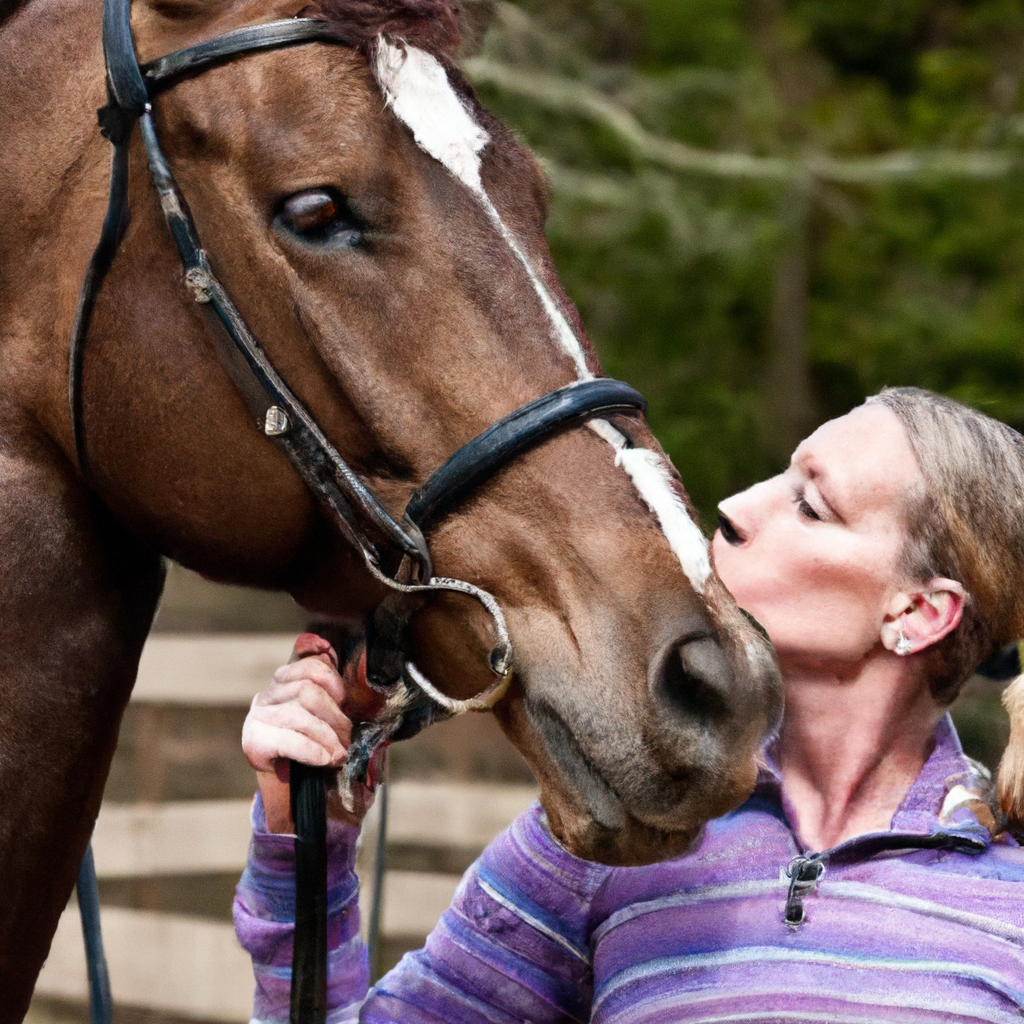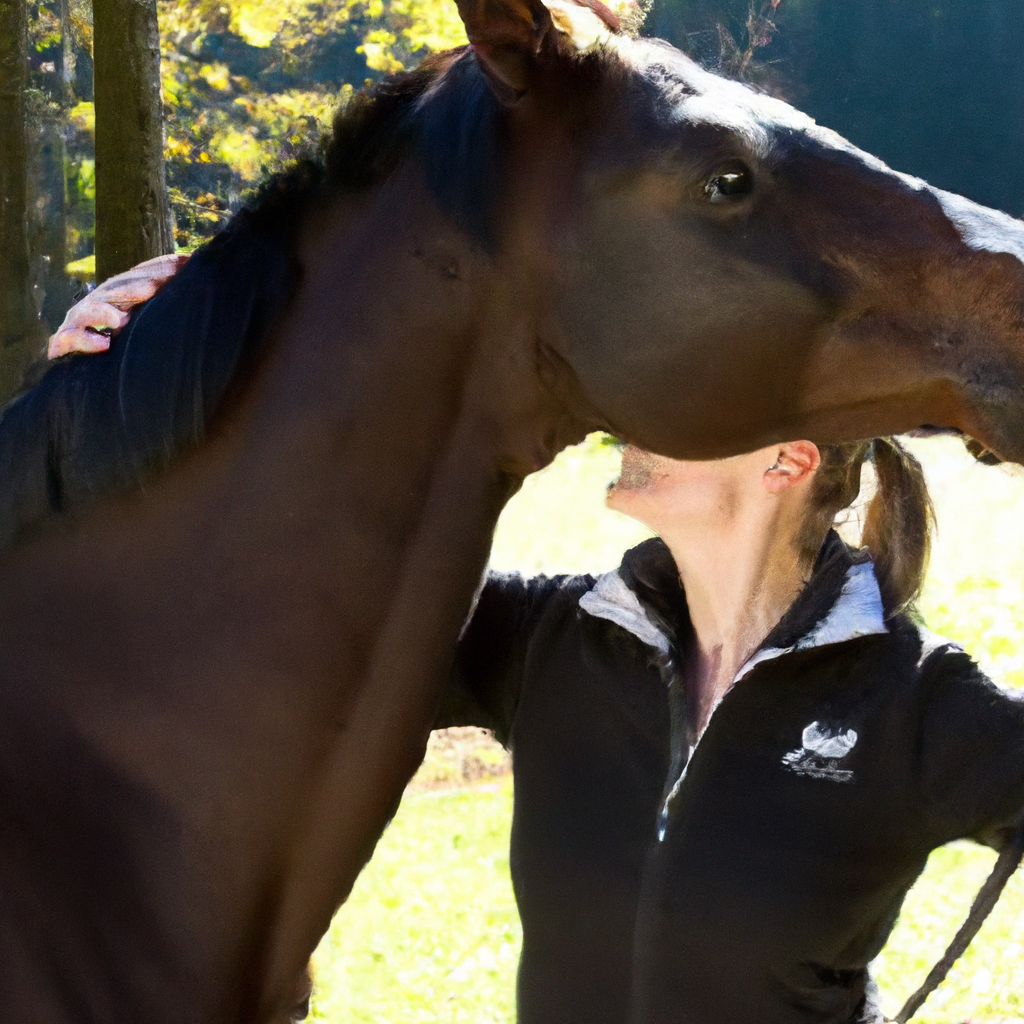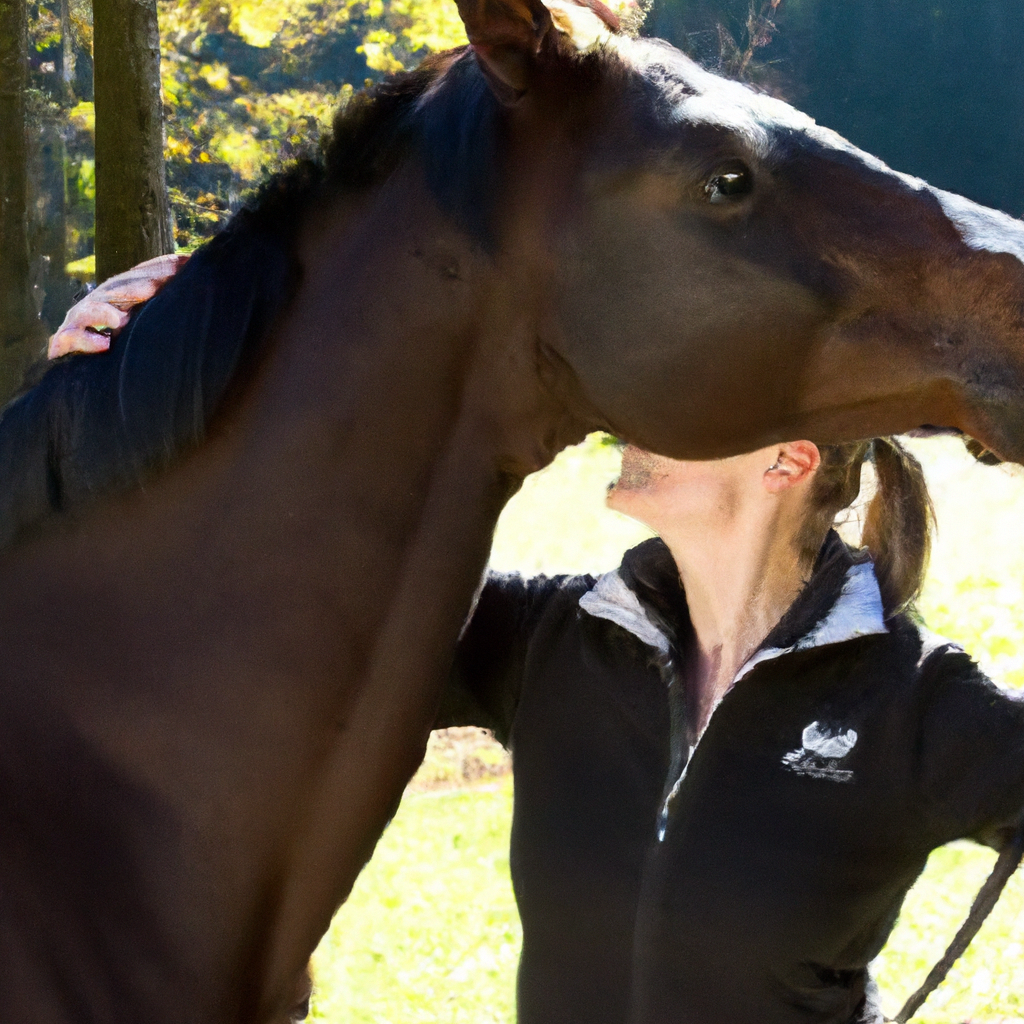In the world of horseback riding, trust plays a crucial role in building a partnership with your horse. Trust is the foundation upon which a strong bond is formed, allowing both rider and horse to work together harmoniously. Without trust, communication becomes challenging, and the overall riding experience may suffer. Whether you’re a seasoned rider or just starting out, understanding the importance of trust in your relationship with your horse is key to achieving success and enjoyment in this incredible sport.”
The Importance of Trust in Building a Partnership with Your Horse
Building a strong partnership with your horse is crucial in horseback riding. Central to this partnership is the foundation of trust. Trust forms the basis of effective communication, mutual respect, and a strong connection between horse and rider. In this article, we will explore the importance of trust in a horse-human relationship, and discover techniques and strategies to develop and maintain trust with your horse.
Understanding Trust in a Horse-Human Relationship
Trust is a two-way street in any relationship, including the one between a horse and its rider. It involves a mutual understanding, respect, and reliance on each other. As a rider, earning your horse’s trust means proving yourself to be a reliable and consistent leader. Trust is not something that can be demanded, but rather it is built over time through positive experiences and consistent interactions.
Developing Trust through Communication and Body Language
Clear and effective communication is vital in establishing trust with your horse. Horses are highly perceptive animals and rely heavily on nonverbal cues. They can read your body language, tone of voice, and energy levels, making it essential to be mindful of your actions when interacting with them.
By learning to communicate effectively through your body language, you can establish trust and a deeper connection with your horse. Focus on maintaining a calm and relaxed posture, be aware of your breathing, and use consistent cues for different commands. Developing this clear line of communication will allow your horse to understand and trust your intentions.
Building Trust through Consistency and Predictability
Consistency and predictability are key ingredients in building trust with your horse. Horses are creatures of habit and thrive in environments where they can anticipate what is expected of them. Establish a routine that includes regular feeding schedules, grooming sessions, and training sessions.
Consistency extends to your riding style as well. By maintaining a balanced seat, using consistent aids, and providing clear expectations, you create a sense of security and reliability for your horse. Consistency helps your horse understand what is expected of them, reducing confusion and anxiety.
Establishing Trust through Groundwork
Before exploring trust-building techniques under saddle, it is important to first establish trust through groundwork. Groundwork refers to activities and exercises done with your horse from the ground, without riding.
Creating a Safe and Respectful Environment
A safe and respectful environment is essential for building trust with your horse. Ensure that the training area is free from distractions and potential hazards. Provide your horse with a comfortable and clean living space, with access to shelter, fresh water, and proper nutrition.
Respect is a two-way street, and it is crucial to treat your horse with kindness and consideration. Avoid using force or punishment as a means of training, as it can damage the trust you are trying to build. Instead, focus on positive reinforcement and reward-based training methods.
Teaching Boundaries and Respect
Teaching your horse boundaries and respect is a fundamental aspect of trust-building. Begin by teaching your horse to yield to pressure, both on the ground and under saddle. This can be done by introducing pressure and releasing it as soon as your horse responds appropriately.
Consistently reinforcing these boundaries will help your horse understand what is expected of them and will build trust in your leadership. It is important to be patient and consistent, as learning takes time and repetition.
Using Desensitization Exercises to Build Trust
Desensitization exercises are valuable tools for building trust and confidence in your horse. By exposing your horse to different stimuli and gradually increasing the level of difficulty, you can help them overcome fear and become more resilient.
Start with small, non-threatening objects or noises and gradually progress to more challenging situations. This could include introducing them to things like tarps, plastic bags, or loud noises. By exposing your horse to a variety of experiences in a controlled and positive manner, you are building trust in their ability to handle new and potentially frightening situations.

Trust-Building Techniques under Saddle
Once you have established a solid foundation of trust through groundwork, it is time to transfer these principles to the saddle. Building trust under saddle requires a focus on your riding technique and creating a positive and secure riding experience for your horse.
Developing a Secure Seat and Balanced Riding
A secure seat and balanced riding are crucial for building trust under saddle. Your position in the saddle should be balanced, with your weight evenly distributed and aligned with your horse’s movement. This allows your horse to move freely and reduces the chances of you inadvertently sending conflicting signals.
Developing a secure seat involves strengthening your core muscles, improving balance, and maintaining a relaxed but engaged posture. Taking regular lessons with a skilled instructor can help you fine-tune your riding technique and improve your overall stability in the saddle.
Using Clear and Consistent Aids
Clear and consistent aids are essential for effective communication and trust-building under saddle. Your aids should be subtle, precise, and easily understood by your horse. Use your legs, seat, and hands in a consistent manner, providing clear instructions for your horse to follow.
Avoid using harsh or conflicting aids, as this can confuse your horse and erode trust. Always reward your horse for responding correctly to your aids, reinforcing the trust they have placed in your guidance.
Gradual Exposure to New Experiences
Gradually exposing your horse to new experiences is an important trust-building technique under saddle. Just as in groundwork, it is crucial to introduce new stimuli in a controlled and positive manner.
Start by incorporating small changes in your riding routine, such as riding in different arenas or on different trails. Gradually expose your horse to new environments, surfaces, and obstacles. Ensure that each new experience is a positive one, rewarding your horse for their bravery and willingness to explore.
Understanding and Addressing Fear in Horses
Fear can be a significant barrier to trust-building in horses. It is important to be able to identify signs of fear or anxiety in your horse and address them appropriately.
Identifying Signs of Fear or Anxiety
Horses express fear and anxiety in various ways. Some common signs include pinned ears, widened eyes, a tense body posture, increased heart rate, and attempts to flee or avoid a certain situation.
As a rider, it is crucial to be observant and attentive to your horse’s body language. Recognizing these signs early on allows you to intervene and address the root cause of their fear, preventing potential trust issues from arising.
Building Trust by Addressing Fearful Situations
When faced with a fearful situation, it is important to remain calm and reassuring to your horse. Horses take cues from their riders, and if they sense fear or anxiety from you, it can intensify their own fears.
Take time to assess the situation and determine the best course of action. If possible, gradually desensitize your horse to the source of their fear, using positive reinforcement and incremental steps. Patience and consistency are key in helping your horse overcome their fears and rebuild trust.
Desensitization and Counter-Conditioning for Fearful Horses
Desensitization and counter-conditioning are valuable techniques for addressing fear in horses. Desensitization involves gradually exposing your horse to the source of their fear, while counter-conditioning involves pairing the fear-inducing stimulus with a positive experience.
For example, if your horse is fearful of crossing water, begin by exposing them to shallow puddles and gradually progress to deeper areas. Reward your horse with treats or praise for their brave behavior, gradually associating the water with positive experiences. Over time, your horse can learn to overcome their fear and trust your guidance.

Trust-Building Activities for Horse and Rider
Trust-building activities not only strengthen the partnership between horse and rider but also provide opportunities for growth and learning. Here are some activities that can help build trust and confidence:
Groundwork Exercises for Trust-Building
Groundwork exercises such as lunging, liberty work, and long-lining are excellent ways to build trust and establish clear communication with your horse. These exercises allow you to work with your horse from the ground, focusing on developing trust, obedience, and respect.
Engaging in groundwork activities also provides an opportunity for you to understand your horse’s body language and behaviors more deeply. By spending time connecting with your horse on the ground, you can strengthen your bond and trust.
Trail Riding and Exposure to New Environments
Trail riding provides valuable opportunities for trust-building. It exposes your horse to new environments, obstacles, and challenges. By gradually introducing your horse to different trails and terrains, you can build trust in their ability to handle unfamiliar surroundings.
Ensure that each trail ride is a positive experience by starting with shorter and easier trails and gradually progressing to more challenging ones. Encourage your horse’s bravery and reward them for their willingness to explore and trust your leadership.
Obstacle Courses and Confidence-Building Exercises
Obstacle courses and confidence-building exercises are valuable tools for trust-building. Designing obstacle courses that include various challenges such as bridges, tarps, poles, and gates encourages your horse to trust your guidance and navigate new experiences.
Start with simple obstacles and gradually increase the difficulty level as your horse gains confidence. Focus on positive reinforcement and reward your horse for their efforts and achievements. Through these exercises, your horse will learn to trust in their own abilities and rely on your guidance.
Addressing Trust Issues in a Partnership
Trust issues can arise in any partnership, including the one between you and your horse. It is important to identify the root causes of trust issues and work towards resolving them.
Identifying Trust Issues and their Causes
Trust issues can manifest in various ways, including your horse exhibiting resistance, anxiety, or disobedience. It is crucial to identify the underlying causes of these behaviors to address them effectively.
Common causes of trust issues can include past traumas, inconsistent training, conflicting cues, or unbalanced riding. By understanding the root cause, you can tailor your approach to rebuilding trust with your horse.
Rebuilding Trust through Patience and Consistency
Rebuilding trust takes time, patience, and consistency. It is important to approach the process with empathy and understanding for your horse’s past experiences and emotions.
Consistency in your interactions, training methods, and cues is essential. Focus on providing clear and fair instructions to your horse, rewarding their efforts, and remaining patient in their progress. Consistency allows your horse to understand and trust in your leadership.
Seeking Professional Help when Trust is Severely Compromised
In some cases, trust issues may be severe or deeply rooted, requiring the assistance of a professional. If you find yourself struggling to rebuild trust with your horse, consider seeking the help of an experienced trainer or equine behaviorist.
These professionals can provide objective guidance, tailor training techniques to your horse’s specific needs, and help you navigate the journey of rebuilding trust. Remember, seeking help is not a sign of weakness but rather a proactive step towards strengthening your partnership.
The Role of Trust in Overcoming Challenges
Trust plays a crucial role in overcoming challenges that may arise during your horseback riding journey. Whether it is tackling a difficult trail, attempting new riding maneuvers, or addressing behavioral issues, trust serves as the foundation for problem-solving and growth.
Trust as a Foundation for Problem Solving
When faced with challenges, having a foundation of trust allows you and your horse to approach them as a team. Trust enables effective communication, shared confidence, and a willingness to work together.
By utilizing the trust you have built, you can problem-solve more effectively and find creative solutions. This teamwork becomes especially valuable when facing unique situations that may require flexibility and adaptability.
Using Trust to Develop a Willing Partner
Trust encourages your horse to become a willing partner. They begin to understand that you have their best interests at heart and that working together yields positive outcomes.
A willing partner is more likely to engage in training, accept new challenges, and willingly follow your guidance. By fostering trust, you create an environment that promotes a cooperative and motivated mindset in your horse.
Overcoming Obstacles and Building Confidence
Trust is essential for overcoming obstacles and building confidence in both you and your horse. Challenges are opportunities for growth, and overcoming them together strengthens the bond between horse and rider.
With trust as the foundation, you and your horse can face obstacles with determination, knowing that you have each other’s support. Each successful hurdle crossed builds confidence and reinforces the trust you have cultivated.
The Effects of Trust on Performance and Training
Trust has a direct impact on the performance and training of both horse and rider. A partnership built on trust allows for enhanced communication, increased confidence, and improved overall performance.
Trust as a Catalyst for Improvement
When trust is present, the horse and rider can work together harmoniously, resulting in improved performance. Trust enables the rider to provide clear and effective aids, allowing the horse to understand and respond appropriately.
A trusting partnership also fosters a willingness in the horse to go above and beyond, pushing their own physical and mental limits. This mutual trust becomes a catalyst for improvement, as both horse and rider strive for excellence.
Trust in Building a Strong Connection and Partnership
Trust is the cornerstone of a strong connection and partnership between horse and rider. It goes beyond obedience and performance, fostering a deeper understanding and bond.
A trusting partnership allows for a heightened level of communication, empathy, and intuition. The horse becomes attuned to the rider’s cues, and the rider can anticipate the horse’s needs and responses. This connection enhances the overall experience and creates a fulfilling and rewarding partnership.
Trust as a Key Factor in Achieving Higher Levels of Performance
In the pursuit of higher levels of performance, trust becomes increasingly important. Advanced maneuvers and disciplines require a high level of skill, accuracy, and synchronization between horse and rider.
When trust is firmly established, the horse and rider can push the boundaries of their abilities, striving for excellence. This level of trust allows for seamless coordination, precise movements, and an elevated level of performance.
Building Trust with Rescue or Traumatized Horses
Rescue or traumatized horses may come with their own set of trust issues and challenges. Building trust with these horses requires a patient and empathetic approach.
Understanding the Unique Challenges of Rescue Horses
Rescue horses often come from traumatic backgrounds, experiencing abuse, neglect, or mistreatment. These experiences can greatly impact their ability to trust humans.
Understanding the unique challenges these horses face is crucial for building trust. It is important to approach them with patience, kindness, and a willingness to rebuild their confidence.
Establishing Trust through Patience and Empathy
Building trust with rescue or traumatized horses requires a significant investment of time and emotional energy. Patience and empathy are essential throughout the process.
Allow the horse to set the pace and gradually expose them to new experiences. Focus on building a positive association with humans through gentle handling, consistent routines, and respect for their boundaries. Over time, trust can blossom as the horse learns to feel safe and secure in their new environment.
Rehabilitation Techniques for Traumatized Horses
Rehabilitation techniques for traumatized horses often involve a combination of groundwork, desensitization exercises, and patience. These techniques help the horse rebuild trust in humans and overcome their fear and anxiety.
Working with a professional experienced in rehabilitating traumatized horses can provide valuable guidance and support. They can tailor a training program to the specific needs of the horse, providing the best possible chance for success.
Maintaining Trust in a Long-Term Partnership
Once trust has been established, it is important to maintain and nurture it throughout the course of your long-term partnership with your horse. Consistent communication, training, and routines play key roles in maintaining trust.
Continued Communication and Connection
Maintaining open lines of communication is essential in a long-term partnership. As a rider, it is important to continually refine your cues and aids to ensure clear and effective communication with your horse.
Regularly engaging in activities that foster connection, such as grooming or spending quality time together outside of training sessions, can help strengthen the bond between horse and rider. Building this ongoing connection reinforces trust on a deeper level.
Consistency in Training and Expectations
Consistency is key in maintaining trust in a long-term partnership. Ensure that your training methods and expectations remain consistent over time. Consistency provides a sense of security and predictability for your horse, reinforcing their trust in your guidance.
Regularly review and assess your training goals and expectations. This allows you to adjust and adapt as needed while still maintaining a clear and consistent approach.
Building Trust-based Routines and Rituals
Routines and rituals can be powerful tools for maintaining trust. Establishing trust-based routines, such as a specific warm-up or cool-down routine, provides a sense of familiarity and reassurance for your horse.
Incorporating rituals, such as a special treat or grooming session after each ride, further strengthens the bond between horse and rider. These routines and rituals become positive associations that reinforce trust and deepen the partnership.
In conclusion, trust is a fundamental aspect of building a strong partnership with your horse. It forms the basis for effective communication, mutual respect, and a strong connection. By understanding and implementing trust-building techniques, both on the ground and under saddle, you can establish a relationship built on trust, leading to greater confidence, performance, and enjoyment in your horseback riding journey.
